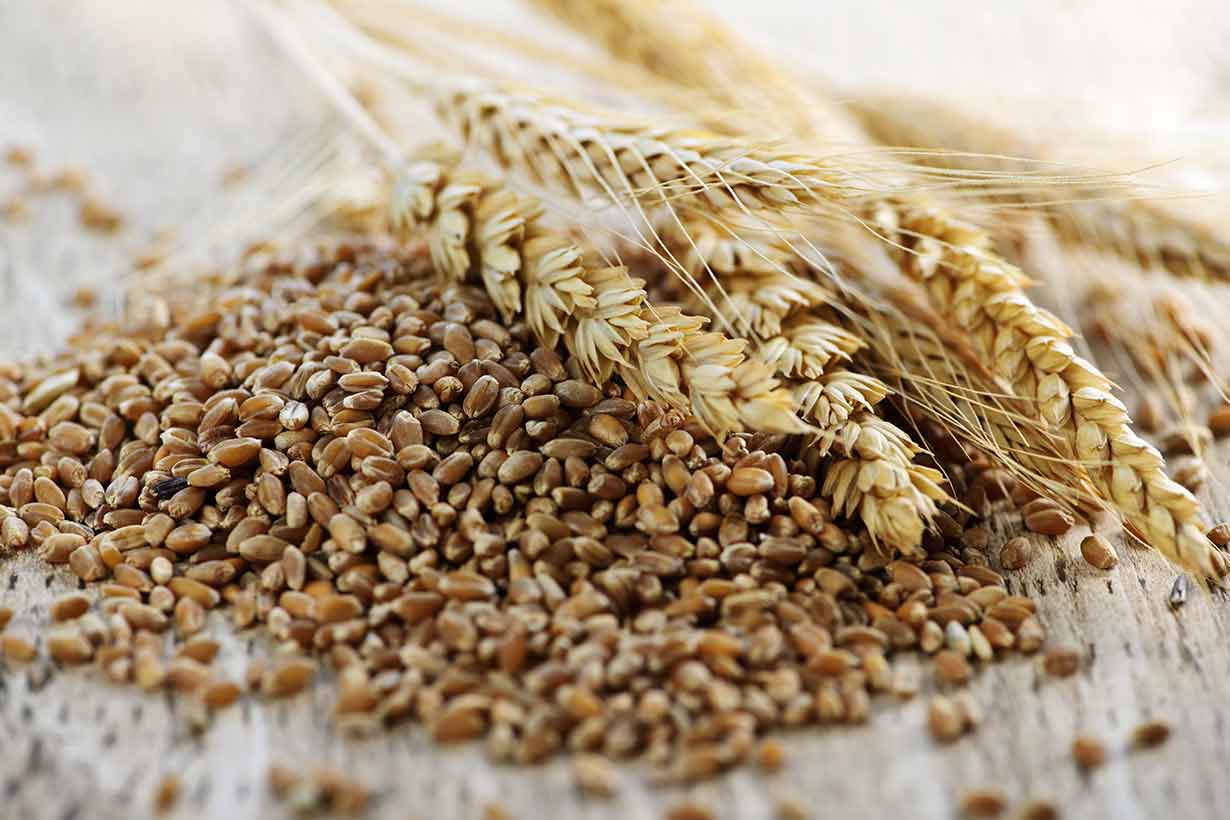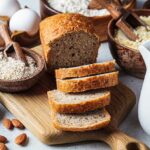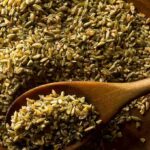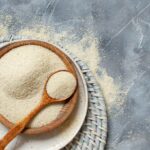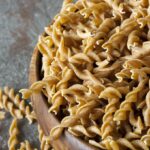Oat bran is a food product made solely from the bran of whole oats. Although similar to regular oatmeal, oat bran has much higher nutrient levels, providing more protein, fiber, and beta-glucan than regular oats per gram.
This article details findings from scientific studies on the benefits of oat bran and examines its full nutritional profile. We also compare the nutritional properties of oat bran and oatmeal.
Table of contents
What Is Oat Bran?
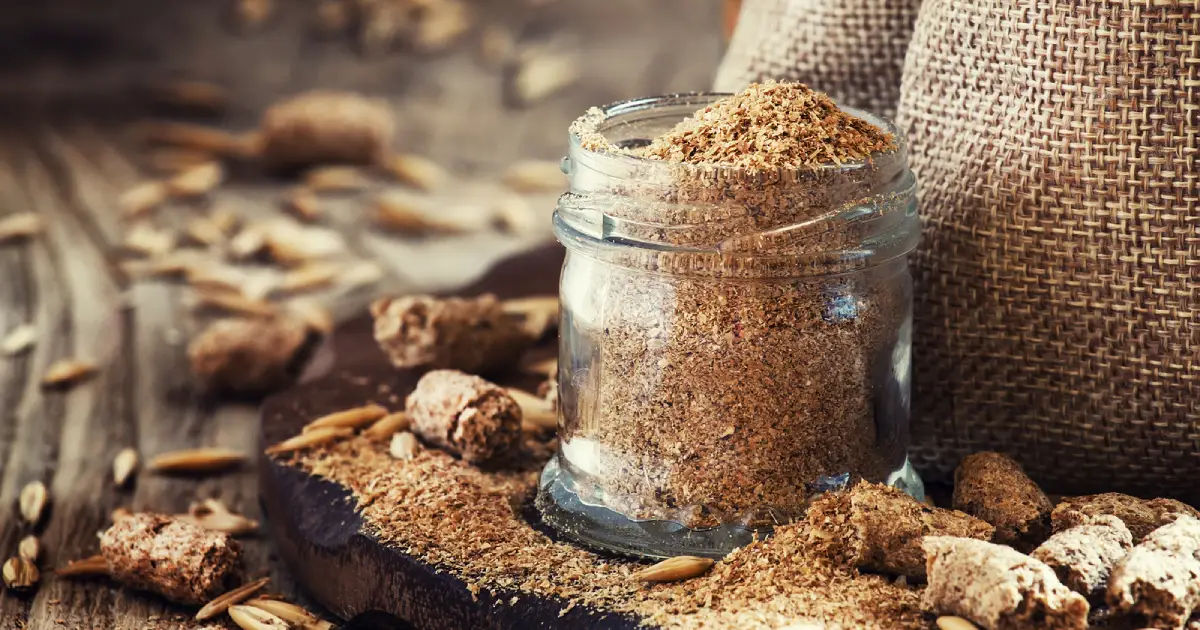
Before we explore the nutritional benefits of oat bran, let’s first clearly define what it is.
Oat bran is the hard, fiber-rich outer layer of the whole oat grain. To make oat bran products, the outer layers of whole oats are separated from the rest of the oat grain and then go through a milling process. Pure oat bran is finer than whole oats and oatmeal products, and it provides a higher concentration of fiber and protein.
Oat Bran vs. Oatmeal
Let’s now look at how oat bran and oatmeal compare nutritionally so that you can appreciate the differences.
The following table shows the comparative calorie, carbohydrate, fiber, fat, protein, and beta-glucan content for oat bran and oatmeal per 100 grams. Beta-glucan is a special type of soluble fiber consistently linked to reducing “bad” LDL cholesterol in human trials.
To ensure the comparison is fully accurate we have used ‘per 100 grams’ nutritional data for raw oat bran and raw rolled oats for oatmeal. Using the raw weights eliminates potential inconsistencies such as the quantities of oats and water used in cooked oatmeal and cooked oat bran.
The nutritional values for oatmeal and oat bran are sourced from the USDA FoodData Central database. You can see the raw data for oat bran here and for rolled oats here.
| Nutrient | Oat Bran (Raw) | Rolled Oats (Raw) |
|---|---|---|
| Calories | 246 kcal | 379 kcal |
| Carbohydrates | 66.2g | 68.7g |
| Dietary fiber | 15.4g | 10.4g |
| Fat | 7.03g | 5.89g |
| Protein | 17.3g | 13.5g |
| Beta-glucan | 10g | 7.52g |
Key Nutritional Differences Between Oat Bran and Rolled Oats
- Oat bran contains approximately one-third fewer calories (246 kcal) than rolled oats (379 kcal) per 100 grams.
- Oat bran provides around 45% more fiber (15.4g) than rolled oats (10.4g)
- Oat bran has just under 30% more protein (17.3g) than rolled oats (13.5g)
In short, oat bran contains significantly fewer calories than rolled oats yet provides more fiber and protein.
If you use equivalent amounts of raw oat bran and raw oats, the cooked oat bran will be lower in calories yet higher in protein and fiber than oatmeal.
Potential Benefits
In this section, we’ll examine findings from scientific research on the potential benefits of oat bran.
May Improve Heart Health By Lowering LDL Cholesterol Levels
Based on the substantive available evidence, the U.S. FDA has allowed foods containing at least 3 grams of beta-glucan from oats or barley to use a health claim that they “may lower the risk of heart disease” as part of a healthy diet.
Beta-glucan, a type of soluble fiber, is known for its ability to lower LDL cholesterol, which is sometimes referred to as “bad” cholesterol.
When consumed, beta-glucan forms into a gel in the intestines as it mixes with liquids. This gel attaches to and binds with bile acids, which are then excreted as the gel passes through the intestines.
Bile acids play a key role in fat digestion, with the liver producing them using cholesterol in the blood. Since beta-glucan intake results in bile acids being lost, the liver has to take additional cholesterol from the blood to make more bile acids.
This has the net effect of lowering circulating total cholesterol and LDL cholesterol (LDL-C) levels.
Consistent research from randomized controlled trials has shown that reducing LDL-C levels lowers the risk of cardiovascular mortality. Furthermore, based on known mechanisms and a variety of research findings, it is widely acknowledged that LDL-C plays a causal role in heart disease.
Findings From Recent Scientific Studies On Oat Bran, Beta-Glucan and LDL Cholesterol
Here are some research findings specific to oat bran or beta-glucan and LDL cholesterol:
- A 2022 systematic review and 2016 review of randomized controlled trials examined the impact of oat beta-glucan supplementation on cholesterol levels. The results found that beta-glucan from oats significantly decreased LDL cholesterol and total cholesterol.
- A 2016 randomized controlled trial involving 132 men and women found that 40 grams of oat bran daily for 90 days significantly lowered LDL cholesterol.
- A 2003 lifestyle intervention in 235 men with high cholesterol levels examined the impact of oat bran supplementation. The study found that a daily intake of 35–50 grams of oat bran significantly reduced total cholesterol and LDL cholesterol.
- A 1991 randomized controlled trial demonstrated that a twice-daily serving of 28 grams of oat bran significantly lowered LDL cholesterol in most participants with high cholesterol. The reduction was superior to that seen in control groups consuming wheat cereals or following diet advice only.
May Lower Blood Sugar Levels
Soluble fiber is well-known for its ability to slow digestion, thereby lowering blood sugar rises following carbohydrate-containing meals.
Raw oat bran is a significant source of dietary fiber, with over 15 grams per 100g, so we would expect it to help with blood sugar regulation.
Findings from recent studies appear to support the blood sugar regulating properties of oat bran:
- A 2022 systematic review and meta-analysis found a consistent association between rising oat beta-glucan doses and progressively lower blood sugar responses. The review also found that minimally processed oat bran has a more significant impact.
- Another 2022 systematic review of randomized controlled trials demonstrated that an average daily dose of 3.25 grams of beta-glucan over approximately 4.5 weeks significantly lowered fasting blood sugar levels in adults with type 2 diabetes. It also lowered HbA1c and insulin resistance markers.
- A 2021 randomized controlled trial investigated the impact of oat bran in gestational diabetes over four weeks. Compared to 56 women following a diet plan only, 56 women consuming 30 grams of oat bran before lunch and dinner saw significant reductions in fasting blood sugar and blood sugar levels two hours after eating.
- A 2018 randomized controlled study found that adding just 0.4 grams of oat bran to 27 grams of instant oatmeal lowered post-meal blood sugar levels by 20% compared to a beta-glucan-free cereal.
Satiety and Digestive Health
As a rich source of soluble fiber, oat bran may also have benefits for:
- Improving digestion and regularity.
- Potentially increasing satiety levels (lowering appetite).
- Improving gut health by feeding the microbiota—the colony of beneficial bacteria in the gut.
Supporting Gut Health
Soluble fiber acts as a prebiotic, a type of carbohydrate that we can’t digest.
It flows through the intestines to the bowel, where bacteria in the gut feed on it, which keeps the microbiota healthy.
Potential Increased Satiety
The beta-glucan in oat bran forms a gel in the intestines, slowing down the speed of digestion, which can help generate feelings of fullness for longer.
This may lower subsequent eating, potentially having benefits for weight management.
Further Potential Benefits
While the evidence base is small, some recent studies have investigated the impact of oat bran on blood pressure and heart rate.
- A 2021 randomized controlled trial involving 50 participants with high blood pressure found that consuming 30 grams of oat bran daily lowered blood pressure and reduced blood pressure medication use.
- A 2022 randomized controlled trial followed, showing that participants consuming 30 grams of oat bran daily had a lower 24 hour average heart rate.
Lowering high blood pressure and heart rate can improve heart health by lowering these markers of cardiovascular risk.
How To Use Oat Bran
It’s easy to incorporate oat bran into your diet; here are some good ways to use it:
- Hot cereal: It’s possible to use oat bran as a replacement for regular oats. To make hot cereal using it, combine one part oat bran with three parts of water or milk. For example, if you use 1/3 cup of oat bran, use 1 cup of liquid. Hot cereal made with oat bran has a smooth and creamy texture more similar to instant oatmeal than rolled or steel cut oats.
- In soups and stews: Simply add a tablespoon or two of oat bran to increase the fiber content of a soup or stew. You can do this near the end of cooking and quickly stir it in.
- Smoothies: Add 1–2 tablespoons of oat bran to your favorite smoothie.
- With yogurt: Mix some oat bran into a yogurt, and enhance it with additional ingredients like fruit and nuts.
Full Nutrition Facts
For those who want to know how much of every vitamin and mineral oat bran provides, here are the full nutrition facts.
Sourced from USDA FoodData Central data, the following tables display oat bran’s nutritional values per 100g and per 94g cup alongside the percent daily values (% DV), which are based on a 2000-calorie diet.
Note: For perspective, a typical serving of cooked oat bran cereal would be made with half a cup of dry oat bran.
Calories and Macronutrients
| Nutrient | Per 100g | Per 94g cup |
|---|---|---|
| Calories | 246 kcal | 231 kcal |
| Carbohydrates | 66.2g (24% DV) | 62.2g (23% DV) |
| Fiber | 15.4g (55% DV) | 14.5g (52% DV) |
| Sugars | 1.45g | 1.36g |
| Fat | 7.03g (9% DV) | 6.61g (8% DV) |
| Saturated fat | 1.33g (7% DV) | 1.25g (6% DV) |
| Monounsaturated fat | 2.38g | 2.24g |
| Polyunsaturated fat | 2.77g | 2.6g |
| Omega-3 | 0.12g | 0.11g |
| Omega-6 | 2.64g | 2.48g |
| Protein | 17.3g (35% DV) | 16.3g (33% DV) |
| Cholesterol | 0 mg (0% DV) | 0 mg (0% DV) |
Vitamins
| Vitamin | Per 100g | Per 94g cup |
|---|---|---|
| Vitamin A (RAE) | 0 mcg (0% DV) | 0 mcg (0% DV) |
| Vitamin C | 0 mg (0% DV) | 0 mg (0% DV) |
| Vitamin D | 0 mcg (0% DV) | 0 mcg (0% DV) |
| Vitamin E | 1.01 mg (7% DV) | 0.95 mg (6% DV) |
| Vitamin K | 3.2 mcg (3% DV) | 3.01 mcg (3% DV) |
| Thiamin (B1) | 1.17 mg (98% DV) | 1.1 mg (92% DV) |
| Riboflavin (B2) | 0.22 mg (17% DV) | 0.21 mg (16% DV) |
| Niacin (B3) | 0.93 mg (6% DV) | 0.88 mg (6% DV) |
| Pantothenic acid (B5) | 1.49 mg (30% DV) | 1.4 mg (28% DV) |
| Vitamin B6 | 0.17 mg (10% DV) | 0.16 mg (9% DV) |
| Folate (B9) | 52 mcg (13% DV) | 48.9 mcg (12% DV) |
| Vitamin B12 | 0 mcg (0% DV) | 0 mcg (0% DV) |
| Choline | 32.2 mg (6% DV) | 30.3 mg (6% DV) |
Minerals
As the table shows, oat bran is an incredibly rich source of thiamin (vitamin B1) and it contains high levels of pantothenic acid (vitamin B5).
| Mineral | Per 100g | Per 94g cup |
|---|---|---|
| Calcium | 58 mg (4% DV) | 54.5 mg (4% DV) |
| Iron | 5.41 mg (30% DV) | 5.08 mg (28% DV) |
| Magnesium | 235 mg (56% DV) | 221 mg (53% DV) |
| Phosphorus | 734 mg (59% DV) | 690 mg (55% DV) |
| Potassium | 566 mg (12% DV) | 532 mg (11% DV) |
| Sodium | 4 mg (<1% DV) | 3.76 mg (<1% DV) |
| Zinc | 3.11 mg (28% DV) | 2.92 mg (27% DV) |
| Copper | 0.40 mg (44% DV) | 0.38 mg (42% DV) |
| Manganese | 5.63 mg (245% DV) | 5.29 mg (230% DV) |
| Selenium | 45.2 mcg (82% DV) | 42.5 mcg (77% DV) |
Oat bran provides very high amounts of most essential minerals. Among these, it contains significant amounts of manganese, selenium, magnesium, phosphorus, and copper.
Potential Drawbacks
While oat bran is a nutrient-rich food which the scientific evidence widely supports as beneficial, there are some potential downsides to consider, as with any food.
Phytate Content Reduces Mineral Absorption
Like most grain products, oat bran contains a plant chemical called phytic acid, also known as phytate.
Phytate can have several benefits, and it has antioxidant properties.
However, it can also bind to the minerals calcium, iron, magnesium, manganese, and zinc, thereby making them harder to absorb. These specific minerals in oat bran are therefore not fully bioavailable, with phytate lowering the percentage that we can absorb.
That said, “lowering” is the key word, and oat bran is still a valuable source of these minerals.
Potential Digestive Discomfort
Oat bran is over 15% fiber by weight, placing it among the most fiber-rich foods.
While fiber can have numerous benefits for our health, significant increases in fiber intake over a short period can sometimes cause digestive discomfort. Some of the potential symptoms of this include bloating and gas.
When making dietary changes around fiber intake, it is typically recommended to slowly and progressively increase fiber consumption. This step-by-step approach allows for the digestive system to gradually adjust to the increased fiber intake.
Since fiber absorbs water, it’s important to ensure sufficient fluid intake when eating high-fiber foods like oat bran.
Summary
As this article shows, oat bran is incredibly nutrient-rich, providing high amounts of fiber, protein, and several essential vitamins and minerals.
It also provides higher levels of most nutrients than regular oats, despite containing fewer calories.
Since scientific research indicates that oat bran may also have benefits for lowering LDL cholesterol and fasting blood sugar, it appears to be a beneficial dietary addition for most individuals.
References
Full List of Scientific References
(Click to Expand)
All citations used within this article are listed below, with full details for each scientific source.
- Junhui Yu et al. (2022). Effects of Oat Beta-Glucan Intake on Lipid Profiles in Hypercholesterolemic Adults: A Systematic Review and Meta-Analysis of Randomized Controlled Trials. Source link
- USDA FoodData Central. (n.d.). Oat Bran, Raw. Source link
- USDA FoodData Central. (n.d.). Oats, Whole Grain, Rolled. Source link
- D. El Khoury et al. (2011). Beta Glucan: Health Benefits in Obesity and Metabolic Syndrome. Source link
- Rebecca Mathews et al. (2020). Global Review of Heart Health Claims For Oat Beta-Glucan Products. Source link
- Susan A. Joyce et al. (2019). The Cholesterol-Lowering Effect of Oats and Oat Beta Glucan: Modes of Action and Potential Role of Bile Acids and the Microbiome. Source link
- Eliano P. Navarese et al. (2018). Association Between Baseline LDL-C Level and Total and Cardiovascular Mortality After LDL-C Lowering: A Systematic Review and Meta-Analysis. Source link
- Michael J. Wilkinson et al. (2023). Evolving Management of Low-Density Lipoprotein Cholesterol: A Personalized Approach To Preventing Atherosclerotic Cardiovascular Disease Across the Risk Continuum. Source link
- Hoang V.T. Ho et al. (2016). The Effect of Oat Beta-Glucan on LDL Cholesterol, Non-HDL Cholesterol and ApoB For CVD Risk Reduction: A Systematic Review and Meta-Analysis of Randomized Controlled Trials. Source link
- Simone Raimondi de Souza et al. (2016). Effects of Oat Bran and Nutrition Counseling on the Lipid and Glucose Profile and Anthropometric Parameters of Hypercholesterolemia Patients. Source link
- Aloys Berg et al. (2003). Effect of an Oat Bran Enriched Diet on the Atherogenic Lipid Profile in Patients with an Increased Coronary Heart Disease Risk: A Controlled Randomized Lifestyle Intervention Study. Source link
- J M Keenan et al. (1991). Randomized, Controlled, Crossover Trial of Oat Bran in Hypercholesterolemic Subjects. Source link
- Eliana Bistriche Giuntini et al. (2022). The Effects of Soluble Dietary Fibers on Glycemic Response: An Overview and Futures Perspectives. Source link
- Jarvis C. Noronha et al. (2022). The Importance of Molecular Weight in Determining the Minimum Dose of Oat Beta-Glucan Required To Reduce the Glycaemic Response in Healthy Subjects Without Diabetes: A Systematic Review and Meta-Regression Analysis. Source link
- Victoria Chen et al. (2022). Effect of Oats and Oat Beta-Glucan on Glycemic Control in Diabetes: A Systematic Review and Meta-Analysis of Randomized Controlled Trials. Source link
- Zahra Barati et al. (2021). The Effect of Oat Bran Consumption on Gestational Diabetes: A Randomized Controlled Clinical Trial. Source link
- Thomas M. S. Wolever et al. (2018). Effect of Adding Oat Bran To Instant Oatmeal on Glycaemic Response in Humans — A Study To Establish the Minimum Effective Dose of Oat Beta-Glucan. Source link
- Great Iruoghene Edo et al. (2025). A Critical Review on the Impacts of Beta-Glucans on Gut Microbiota and Human Health. Source link
- Muriel Henrion et al. (2019). Cereal Beta-Glucans: The Impact of Processing and How It Affects Physiological Responses. Source link
- Yuan Xue et al. (2021). The Effect of Dietary Fiber (Oat Bran) Supplement on Blood Pressure in Patients with Essential Hypertension: A Randomized Controlled Trial. Source link
- Yang Ju et al. (2022). Effect of Dietary Fiber (Oat Bran) Supplement in Heart Rate Lowering in Patients with Hypertension: A Randomized DASH-Diet-Controlled Clinical Trial. Source link
- Paolo Palatini (2025). High Heart Rate and Hypertension: Two Intertwined Cardiovascular Risk Factors. Source link
- Sonia M G Pires et al. (2023). Phytates as a Natural Source for Health Promotion: A Critical Evaluation of Clinical Trials. Source link
- Raj Kishor Gupta et al. (2013). Reduction of Phytic Acid and Enhancement of Bioavailable Micronutrients in Food Grains. Source link
- UCLA Health. (2022). Increasing Fiber In Your Diet May Increase Gas. Source link

